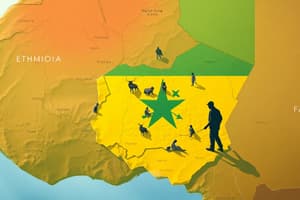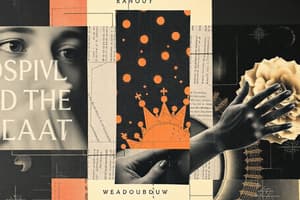Podcast
Questions and Answers
What is a main characteristic of the arena stage?
What is a main characteristic of the arena stage?
- The audience is situated on all sides of the stage. (correct)
- The stage is always located at the center of the theatre.
- The audience is separated from the acting space by a proscenium arch.
- The stage is typically elevated on a raised platform.
Which type of theatre is mentioned as a possible evolutionary origin for the arena stage?
Which type of theatre is mentioned as a possible evolutionary origin for the arena stage?
- Medieval theatre
- Renaissance theatre
- Elizabethan theatre
- Ancient Greek theatre (correct)
What is the primary benefit of using an arena stage in terms of audience experience?
What is the primary benefit of using an arena stage in terms of audience experience?
- It allows for more elaborate set design and special effects.
- It offers a more immersive and intimate connection to the performance. (correct)
- It provides a more visually spectacular presentation.
- It allows for a greater number of audience members.
What is a potential challenge of using an arena stage?
What is a potential challenge of using an arena stage?
Which of these is NOT a part of a typical proscenium stage setup, as described in the text?
Which of these is NOT a part of a typical proscenium stage setup, as described in the text?
Which of these elements is NOT specifically mentioned in the text as influencing the development of the arena stage?
Which of these elements is NOT specifically mentioned in the text as influencing the development of the arena stage?
What is the main difference between the proscenium stage setup and the Bibiena set?
What is the main difference between the proscenium stage setup and the Bibiena set?
Which of these is NOT a synonym for the term "arena stage" as used in the text?
Which of these is NOT a synonym for the term "arena stage" as used in the text?
Who is credited for developing methods of seamlessly moving scenery on and off the proscenium stage?
Who is credited for developing methods of seamlessly moving scenery on and off the proscenium stage?
What is the main reason why the Bibiena sets became so popular in the 18th century?
What is the main reason why the Bibiena sets became so popular in the 18th century?
What is the primary purpose of the text?
What is the primary purpose of the text?
What happened during the 18th century that led to an over-emphasis on the visual aspects of theatre?
What happened during the 18th century that led to an over-emphasis on the visual aspects of theatre?
Which of these is an accurate statement based on the text?
Which of these is an accurate statement based on the text?
What is the typical layout of a formal proscenium theatre, according to the text?
What is the typical layout of a formal proscenium theatre, according to the text?
What was the major advancement in stage design that took place during the 18th century?
What was the major advancement in stage design that took place during the 18th century?
Which of these statements describes the visual style of Bibiena sets?
Which of these statements describes the visual style of Bibiena sets?
What is a key characteristic of the Oerol Festival in the Netherlands?
What is a key characteristic of the Oerol Festival in the Netherlands?
What approach did Grotowski employ in his production of the Doctor Faustus story?
What approach did Grotowski employ in his production of the Doctor Faustus story?
Which of the following is a distinguishing feature of site-specific theatre?
Which of the following is a distinguishing feature of site-specific theatre?
Which of these practices is NOT mentioned as a common approach in site-specific theatre?
Which of these practices is NOT mentioned as a common approach in site-specific theatre?
What is the main idea conveyed by examples like Punchdrunk's Sleep No More and Grotowski's productions?
What is the main idea conveyed by examples like Punchdrunk's Sleep No More and Grotowski's productions?
How does 'Street Theatre' relate to the concept of site-specific theatre?
How does 'Street Theatre' relate to the concept of site-specific theatre?
Why is the mentioned production of 'Salted' relevant to the discussion of the Oerol Festival?
Why is the mentioned production of 'Salted' relevant to the discussion of the Oerol Festival?
Which statement best describes the evolution of theatre spaces discussed in the context?
Which statement best describes the evolution of theatre spaces discussed in the context?
What is the ideal theatre style for large-scale productions?
What is the ideal theatre style for large-scale productions?
Which position on stage refers to the area closest to the audience?
Which position on stage refers to the area closest to the audience?
What is the term used to describe the right side of the stage from a performer's perspective?
What is the term used to describe the right side of the stage from a performer's perspective?
Which of the following is NOT a characteristic of a proscenium stage?
Which of the following is NOT a characteristic of a proscenium stage?
What type of theatre offers a sense of intimacy and proximity to the action?
What type of theatre offers a sense of intimacy and proximity to the action?
In the context of the text, what does the phrase "as if by magic" refer to?
In the context of the text, what does the phrase "as if by magic" refer to?
What is the primary benefit of using a proscenium stage for large-scale productions?
What is the primary benefit of using a proscenium stage for large-scale productions?
What is a characteristic of a thrust stage that distinguishes it from a proscenium stage?
What is a characteristic of a thrust stage that distinguishes it from a proscenium stage?
What was Artaud's primary aim in his proposition on the physical theatre?
What was Artaud's primary aim in his proposition on the physical theatre?
What specific type of architecture did Artaud suggest as a model for creating physical theatre spaces?
What specific type of architecture did Artaud suggest as a model for creating physical theatre spaces?
What distinguishes the use of nontheatrical spaces in contemporary theatre from historical precedents?
What distinguishes the use of nontheatrical spaces in contemporary theatre from historical precedents?
Which of the following is NOT mentioned as a specific example of a nontheatrical space used for contemporary performance?
Which of the following is NOT mentioned as a specific example of a nontheatrical space used for contemporary performance?
Based on the text, which of the following best describes the relationship between Artaud's ideas and later theatre practices?
Based on the text, which of the following best describes the relationship between Artaud's ideas and later theatre practices?
What does the term "site-specific" refer to in the context of contemporary theatre?
What does the term "site-specific" refer to in the context of contemporary theatre?
How does the text differentiate between the use of nontheatrical spaces in contemporary theatre and the conversion of such spaces into full-scale theatres in the past?
How does the text differentiate between the use of nontheatrical spaces in contemporary theatre and the conversion of such spaces into full-scale theatres in the past?
What is the significance of Jerzy Grotowski's contribution to the development of theatre space?
What is the significance of Jerzy Grotowski's contribution to the development of theatre space?
What is a key characteristic of a multifocus event, as described in the text?
What is a key characteristic of a multifocus event, as described in the text?
How does the text compare the experience of watching a multifocus event to everyday life?
How does the text compare the experience of watching a multifocus event to everyday life?
What is a significant advantage of using a multipurpose theatre space, according to the text?
What is a significant advantage of using a multipurpose theatre space, according to the text?
How does the text characterize the typical configuration of spaces used for popular entertainment?
How does the text characterize the typical configuration of spaces used for popular entertainment?
What is a core principle underlying multifocus productions, according to the text?
What is a core principle underlying multifocus productions, according to the text?
How does the text suggest that audiences can engage with multifocus events?
How does the text suggest that audiences can engage with multifocus events?
What is a significant difference between typical theatrical spaces and those used for popular entertainment, as described in the text?
What is a significant difference between typical theatrical spaces and those used for popular entertainment, as described in the text?
How does the text suggest that the audience can influence the dynamics within a popular performance space?
How does the text suggest that the audience can influence the dynamics within a popular performance space?
Flashcards
Proscenium Theatre
Proscenium Theatre
A stage design where the audience views from one side through a 'picture frame' arch.
Apron
Apron
The area in front of the stage's proscenium arch; often extending toward the audience.
Fly Loft
Fly Loft
Space above the stage where scenery can be raised out of view.
Bibiena Family
Bibiena Family
Signup and view all the flashcards
Stage Machinery
Stage Machinery
Signup and view all the flashcards
Scene Painting
Scene Painting
Signup and view all the flashcards
Spectacle in Theatre
Spectacle in Theatre
Signup and view all the flashcards
Giacomo Torelli
Giacomo Torelli
Signup and view all the flashcards
Stage Right
Stage Right
Signup and view all the flashcards
Stage Left
Stage Left
Signup and view all the flashcards
Downstage
Downstage
Signup and view all the flashcards
Upstage
Upstage
Signup and view all the flashcards
Arena Theatre
Arena Theatre
Signup and view all the flashcards
Thrust Theatre
Thrust Theatre
Signup and view all the flashcards
Scenic Effects
Scenic Effects
Signup and view all the flashcards
Arena Stage
Arena Stage
Signup and view all the flashcards
Circle Theatre
Circle Theatre
Signup and view all the flashcards
Theatre-in-the-Round
Theatre-in-the-Round
Signup and view all the flashcards
Intimacy in Theatre
Intimacy in Theatre
Signup and view all the flashcards
Ancient Stage Arrangements
Ancient Stage Arrangements
Signup and view all the flashcards
Entry and Exit in Arena Theatre
Entry and Exit in Arena Theatre
Signup and view all the flashcards
Demarcation in Arena Theatre
Demarcation in Arena Theatre
Signup and view all the flashcards
Advantages of Arena Theatre
Advantages of Arena Theatre
Signup and view all the flashcards
Physical Theatre
Physical Theatre
Signup and view all the flashcards
Site-Specific Theatre
Site-Specific Theatre
Signup and view all the flashcards
Artaud's Proposals
Artaud's Proposals
Signup and view all the flashcards
Non-Theatre Structures
Non-Theatre Structures
Signup and view all the flashcards
Avant-Garde Movement
Avant-Garde Movement
Signup and view all the flashcards
Grotowski's Experiments
Grotowski's Experiments
Signup and view all the flashcards
Envelopment in Theatre
Envelopment in Theatre
Signup and view all the flashcards
Unusual Performance Spaces
Unusual Performance Spaces
Signup and view all the flashcards
Oerol Festival
Oerol Festival
Signup and view all the flashcards
Grotowski's Approach
Grotowski's Approach
Signup and view all the flashcards
Nontraditional Settings
Nontraditional Settings
Signup and view all the flashcards
Street Theatre
Street Theatre
Signup and view all the flashcards
Interactive Audience Experience
Interactive Audience Experience
Signup and view all the flashcards
Terschelling Island
Terschelling Island
Signup and view all the flashcards
Production Adaptation
Production Adaptation
Signup and view all the flashcards
Multifocus Event
Multifocus Event
Signup and view all the flashcards
Black Box Theatre
Black Box Theatre
Signup and view all the flashcards
Multipurpose Space
Multipurpose Space
Signup and view all the flashcards
Spectator Interaction
Spectator Interaction
Signup and view all the flashcards
Stage Configuration
Stage Configuration
Signup and view all the flashcards
Arenas as Performance Spaces
Arenas as Performance Spaces
Signup and view all the flashcards
Electrifying Interactive Entertainment
Electrifying Interactive Entertainment
Signup and view all the flashcards
Impression Synthesis
Impression Synthesis
Signup and view all the flashcards
Study Notes
Theatre Spaces
- Theatre experiences begin before the performance, encompassing activities like reading play reviews, buying tickets, and meeting with others.
- The theatre environment strongly influences audience mood and experience.
- Formal settings, like auditoriums with ornate decorations, evoke different feelings than converted warehouses with simple staging.
- Theatre environments, whether traditional or experimental, are now recognized as significant aspects of performance experience.
- The physical arrangement of the theatre space significantly conditions the audience's experience.
Stage Spaces
- The proscenium (picture-frame) stage, a common Broadway style, frames the stage with an enclosed arch. Audience sits facing the stage.
- An arena (or circle) stage places the audience around the stage, creating a more intimate relationship with the performers.
- The thrust stage features a stage area jutting into the audience seating on three sides, providing a wraparound effect.
- Found spaces use non-traditional locations as theatrical venues, ranging from barns to outdoor gardens or streets.
- All-purpose ("black box") theatres provide adaptable spaces with flexible arrangements for various types of productions.
Importance of the Stage
- The proscenium stage is ideal for large-scale productions due to its ability to conceal scenery and stage machinery.
- Realistic scenery is easier to create in a proscenium stage.
- The arena stage facilitates a strong connection between performers and audience as the audience is close to the stage.
- The thrust stage offers a sense of intimacy and a wraparound effect which engages the audience's full attention to the stage.
- The thrust stage is best suited for plays that require simple settings.
- The arena stage is frequently used for smaller productions
- The proscenium stage is widely used for large-scale musicals which require elaborate scenery, lighting and sound effects.
- Stage space can enhance the play and create a more engaging experience for the audience.
- Modern theatres utilize different configurations based on the type of play or production.
- Consideration of the space's size, shape, location (indoor/outdoor) and design, all enhance the overall environment.
Studying That Suits You
Use AI to generate personalized quizzes and flashcards to suit your learning preferences.



